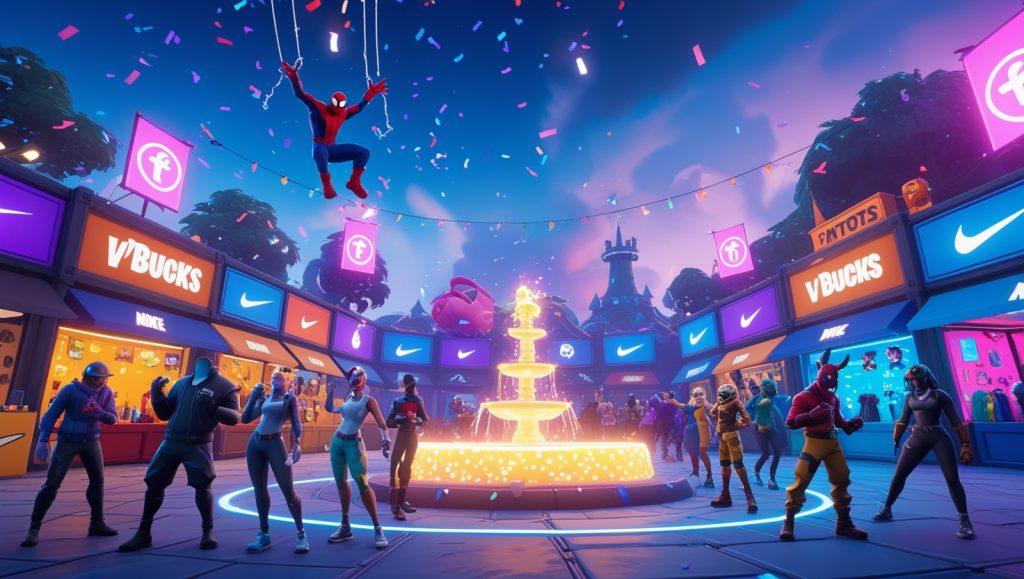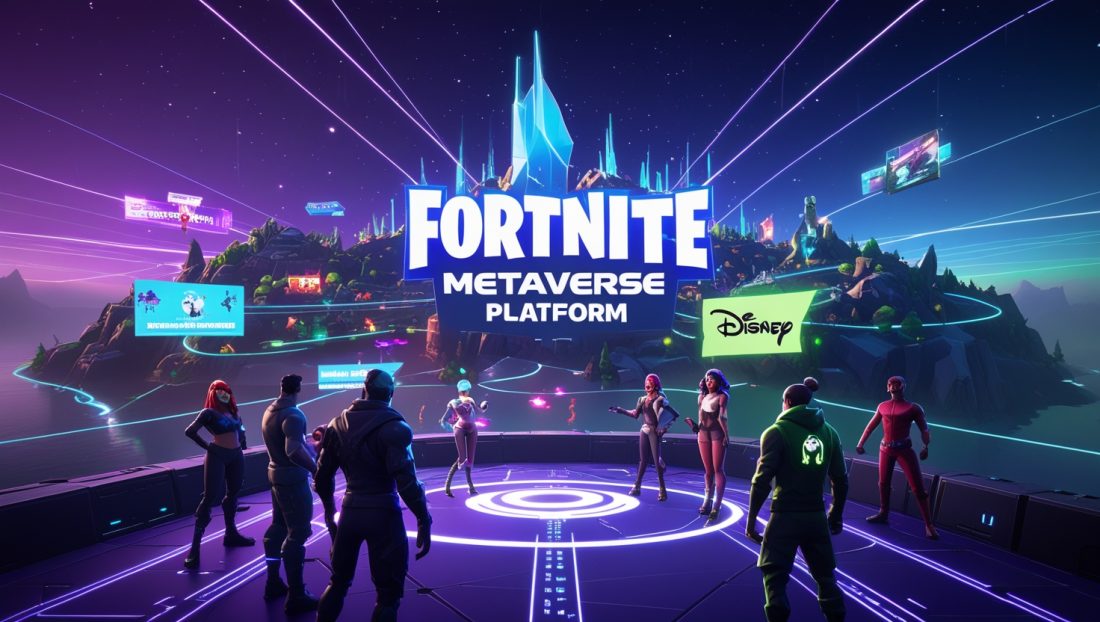Fortnite in 2025 is no longer just a battle royale—it’s a cultural and technological titan. Through its Fortnite metaverse platform, Epic Games is crafting a virtual universe that blends gaming, social interaction, and creator-driven innovation. From hosting Travis Scott concerts to partnering with Disney, Fortnite is pushing boundaries, aiming to be the internet’s next evolution. But why does this matter, and could it truly revolutionize gaming? Let’s dissect the mechanics, impact, and unfiltered truths of the Fortnite metaverse platform, exploring what makes it a potential juggernaut and where it falters.
What Is the Fortnite Metaverse Platform?
The Fortnite metaverse platform is Epic Games’ ambitious pivot from a game to a persistent, interconnected virtual world. It’s a digital space where players can battle, socialize, attend events, or create their own experiences, all powered by Unreal Engine. Think of it as a hybrid of gaming, social media, and a creator marketplace. You might drop into a match as Iron Man, join a virtual Eminem concert, or build an island with LEGO blocks—all within Fortnite’s ecosystem.
Epic’s $1.5 billion Disney deal in 2024 underscores its vision: a seamless universe where assets like skins or emotes could transfer across games or platforms. Unlike Meta’s VR-focused Horizon Worlds or Decentraland’s niche blockchain approach, Fortnite’s mass appeal and accessibility (free-to-play, cross-platform) give it an edge. For gamers tweaking performance, our guide on how to optimize ping settings for lower lag in Blood Strike offers tips that apply to Fortnite’s connectivity needs.
Why the Fortnite Metaverse Platform Stands Out
Cultural Magnetism
Fortnite’s cultural pull is colossal. With over 400 million registered players, it’s a Gen Z hub, weaving pop culture into its fabric—think Spider-Man skins, Star Wars events, or even Balenciaga collabs. The Verge calls it a “goofy, joyful zoo” of IPs, from Goku to Kratos, creating a metaverse that feels alive. This resonance draws brands like Nike, who see Fortnite as a virtual marketing powerhouse.
Meta’s Horizon Worlds, by contrast, feels lifeless, with under 675 daily users in Decentraland. Fortnite’s vibrant, accessible aesthetic (no VR headset needed) makes it a social staple. For account management tips, check our guide on how to logout and login with a guest account in COD Mobile to see how Fortnite could simplify cross-platform access.
A Robust Digital Economy
The Fortnite metaverse platform thrives on its V-Bucks economy, generating $9 billion in two years. Players buy skins, emotes, and passes, fueling a marketplace Epic wants to make interoperable—imagine a skin usable in Fortnite and a Disney game. This could make digital purchases feel like real investments, not fleeting cosmetics.
But the model has flaws. Microtransactions can exploit younger players, and locked battle pass exclusives (like Darth Vader) frustrate fans, undermining the metaverse’s “be who you want” ethos. For resource management tips, see our article on how to level up weapons fast in Blood Strike without playing matches.
Why It Could Ignite a Gaming Revolution

Redefining Social Connection
Fortnite’s Party Royale mode, a no-combat zone since 2020, lets players hang out, watch films, or attend concerts. The 2019 Travis Scott event drew 12 million, proving Fortnite’s social clout. Unlike Zoom, its 3D avatar-driven world feels immersive, serving as a lockdown-era lifeline for friends. Forbes notes Fortnite’s 2023 LEGO launch siphoned Minecraft players, showing its knack for diverse social experiences.
This could shift gaming from solo grinds to communal hubs. For gameplay tweaks, our guide on how to enable quick weapon switch in Call of Duty Mobile highlights flow-enhancing tips, mirroring Fortnite’s social seamlessness.
Empowering Creators
The Fortnite metaverse platform leans heavily on user-generated content via the Unreal Editor for Fortnite (UEFN). Players craft islands, games, or events, rivaling Roblox’s creative sandbox. The upcoming Fab marketplace, tied to Unreal Engine 6, will let creators monetize assets, fostering a vibrant economy. Epic’s 40% revenue share is fairer than Apple’s 30%, but UEFN’s steep learning curve and uneven payouts favor pros over newbies.
The Good: What the Fortnite Metaverse Platform Masters
Unrivaled Accessibility
Free-to-play and available on everything from phones to PCs, Fortnite welcomes all. Its 15 million peak concurrent players dwarf VR platforms like Meta Quest, which demand costly hardware. This inclusivity makes the Fortnite metaverse platform a true mass-market metaverse.
Innovative Experiences
From black-hole map resets to LEGO Fortnite’s survival mode, Epic keeps players hooked with dynamic events. These aren’t just stunts—they’re proof Fortnite can evolve in real time, a metaverse must-have. The 2023 racing and music modes, inspired by Rocket League and Rock Band, show Epic’s genre-blending chops.
The Bad: Where the Fortnite Metaverse Platform Falters
IP Saturation
Fortnite’s IP zoo—Batman, Naruto, Peter Griffin—is a strength but risks turning the metaverse into a corporate ad fest. Constant collabs can overwhelm, burying Fortnite’s original vibe. Epic needs balance to avoid feeling like a pop-culture slot machine.
Technical and Ethical Risks
Interoperability across platforms like Roblox sounds promising but is a technical beast. Blockchain could enable asset sharing but raises privacy and security red flags. Epic’s 2023 layoffs, tied to overzealous metaverse spending, hint at shaky execution. IGN explores these challenges in its metaverse gaming outlook.
Why It’s Heading This Way
Industry Momentum
Gaming is merging with tech, chasing new markets. The Fortnite metaverse platform positions Epic as a titan, not just a studio. Disney and Hadean partnerships signal Epic’s edge over Meta’s VR pivot. Forbes notes Fortnite’s 2023 LEGO launch hit record player counts, outpacing Steam’s entire catalog.
Player Craving for Immersion
Gamers want persistent worlds. Fortnite’s Zero Point lore and cataclysmic events feed this desire. As 5G and cloud gaming grow, Fortnite could integrate with tech like PlayStation VR3’s haptic feedback, deepening immersion.
FAQ: Unpacking the Fortnite Metaverse Platform
What is the Fortnite metaverse platform?
It’s Epic Games’ vision of Fortnite as a virtual universe blending gaming, social spaces, and creator tools, powered by Unreal Engine and partnerships like Disney.
How does it compare to Meta’s metaverse?
Fortnite’s platform is accessible, fun, and culturally vibrant, while Meta’s Horizon Worlds relies on costly VR and lacks engagement.
Can players create content in Fortnite’s metaverse?
Yes, UEFN lets players build islands or games, with Fab marketplace enabling asset monetization, though it’s complex for beginners.
What are the downsides?
IP overload, locked exclusives, technical interoperability hurdles, and microtransaction ethics could derail its potential.
Will it replace traditional gaming?
Not fully, but it could redefine gaming as a social, creative ecosystem, prioritizing connection over competition.
The Fortnite Metaverse Platform’s Future
The Fortnite metaverse platform is a bold bet on gaming’s future. Its accessibility, cultural clout, and creator tools make it a metaverse frontrunner, but IP saturation, technical hurdles, and ethical concerns loom. In 2025, Fortnite isn’t just a game—it’s a glimpse of the internet’s next era. Will Epic nail it? The potential is sky-high, but execution is everything.
Ready to level up? Dive into our Gaming Tech guides for expert tips to conquer the virtual world. Share your thoughts on Fortnite’s metaverse breakthrough in the comments below—we’d love to hear your take! Subscribe to stay in the loop for the latest gaming trends and updates

